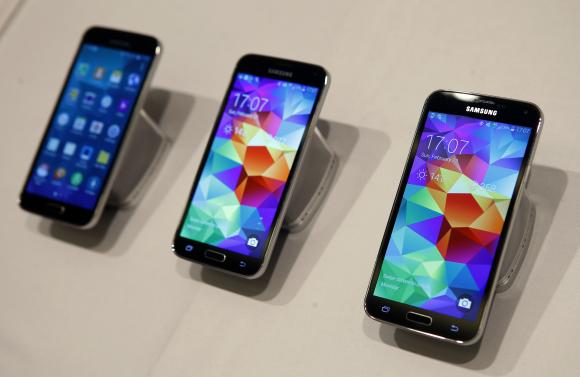(Reuters) – The mobile phone industry is now looking to the fast-growing demand for smartphones priced at $100 or below as the market for fancier high-end devices has become saturated, but not all handset makers are able or willing to trade down.

Much of the talk this week at the Mobile World Congress in Barcelona, the industry’s biggest annual trade fair, has turned from the latest big screen, premium-priced devices to the new, entry-level smartphones that analysts say now overwhelmingly represent the industry’s best hope for growth.
All the phones now look the same, said industry analyst Ben Wood of CCS Insight after surveying the eight vast halls of phones and other mobile gadgets on show.
The ability of top brands like Samsung, Apple and Nokia to differentiate themselves is getting harder, he said.
Growth in global smartphone shipments will fall sharply this year and keep slowing through 2018, with average prices dropping significantly as the demand shifts to China and other developing countries, market research firm IDC said earlier on Wednesday.
So now phone makers are touting new, low-cost devices which are intended to retail at near $100 or below. This class of device has some but not all the features of the current top end smartphones, which sell for several hundreds of dollars and until this year drew nearly all the media attention and marketing spend at Barcelona.
Early leaders in this new market are Chinese players, some with global brand names and others who remain virtually unknown outside China, who have made huge strides in acquiring the technical and design expertise that enables them to now drive down the costs without necessarily sacrificing quality.
The biggest winners so far look to be Huawei , Lenovo, TCL Communications and still unfamiliar upstarts like Gionee, Oppo and CorePad that are poised to become big international names in the coming years, said Wood.
All benefit from having a home field advantage in China, the world’s largest phone market.
NOKIA X
This shifting landscape has already forced Nokia, the former mobile world-beater now struggling to stay relevant, to adopt Google’s Android software to gain entry to the low-end smartphone market, despite Android being an arch rival of Nokia’s new-owner-to-beMicrosoft.
Launching the 89-euro ($120) Nokia X, Stephen Elop, chief executive of the Finnish group, called the sub-$100 range, a massive opportunity with that segment of the smartphone market now growing four times faster than the rest of the market.
Wood said Nokia’s move spoke volumes about the pressures the whole industry was feeling.
The cheaper end of the smartphone market has become such a big opportunity that, eventually, Nokia had to go to a rival software system — Google’s Android, he said, describing the move as hugely controversial, but necessary.
The cheap stripped-down smartphones, which often sacrifice big screens, memory, and camera quality and have fewer novelty features such as fingerprint recognition, are designed to reach potentially billions of new consumers in emerging markets.
Smartphone sales last year overtook for the first time sales of so-called basic ‘feature’ phones, which focus on just calls and texts with a pared down Internet access, according to market tracking firm Strategy Analytics.
And IDC analyst Francisco Jeronimo said smartphone sales in the sub-$100 category alone more than tripled to hit 159 million last year from 45.4 million in 2012. Sub-$50 smartphones grew even faster, up from just 900,000 in 2012 to 19.5 million last year.
COMPONENT SUPPLIES
However, this growth in demand is pushing up the cost of components, a surprising twist in an industry more familiar with falling material prices as technology evolves.
China’s ZTE Corp, whose mobile business is aiming for 50 percent growth in shipments to 60 million phones this year, has seen the component supply crunch.
All vendors face the challenge of the cost of key hardware components such as screen displays, memory and keyboards, said Qian Hao Lv, head of ZTE’s device strategy. These are crucial to differentiate one model from the next.
Nonetheless, Kan Yulun, another ZTE executive, said that the company was working on new technologies to drive the cost of smartphones down to $50 or below without compromising on quality.
We will find tech solutions to reach the $50 price target by the end of this year, Yulun said.
He said he often hears from telecom operators in Africa, who still sell lots of feature phones, that they were now hungry for smartphones but need prices to come down to below $50.
The head of the pack in the sub-$100 race is the Alcatel Onetouch brand owned by TCL. Its brightly-colored Idol family of phones have already proven a hit in Latin America and Europe and the firm launched two new phones for under $100 at the Mobile World Congress this week that can run on 4G mobile networks being rolled out in China, Brazil, and elsewhere.
But while many players are now chasing the lower end of the market not all are, fearing that stripped-down hardware features can only lead to a commoditized market where no one can differentiate and maintain a worthwhile profit margin.
Huawei, the world’s third-biggest phone maker, prefers to aim higher by increasing the proportion of its phones that sell for 300 euros ($400) or more as opposed to the low-end it defines as under 150 euros.
We are not interested in the sale volume of those low-end, low-priced phones, said Chief Executive Eric Xu.
($1=0.7317 euros)
(Additional reporting by Leila Abboud; Editing by Greg Mahlich)





